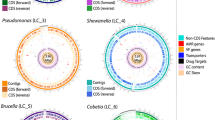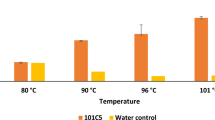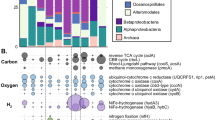Abstract
Oil reservoirs represent a nutrient-rich ecological niche of the deep biosphere. Although most oil reservoirs are occupied by microbial populations, when and how the microbes colonized these environments remains unanswered. To address this question, we compared 11 genomes of Thermotoga maritima-like hyperthermophilic bacteria from two environment types: subsurface oil reservoirs in the North Sea and Japan, and marine sites located in the Kuril Islands, Italy and the Azores. We complemented our genomes with Thermotoga DNA from publicly available subsurface metagenomes from North America and Australia. Our analysis revealed complex non-bifurcating evolutionary history of the isolates’ genomes, suggesting high amounts of gene flow across all sampled locations, a conjecture supported by numerous recombination events. Genomes from the same type of environment tend to be more similar, and have exchanged more genes with each other than with geographically close isolates from different types of environments. Hence, Thermotoga populations of oil reservoirs do not appear isolated, a requirement of the ‘burial and isolation’ hypothesis, under which reservoir bacteria are descendants of the isolated communities buried with sediments that over time became oil reservoirs. Instead, our analysis supports a more complex view, where bacteria from subsurface and marine populations have been continuously migrating into the oil reservoirs and influencing their genetic composition. The Thermotoga spp. in the oil reservoirs in the North Sea and Japan probably entered the reservoirs shortly after they were formed. An Australian oil reservoir, on the other hand, was likely colonized very recently, perhaps during human reservoir development.
Similar content being viewed by others
Log in or create a free account to read this content
Gain free access to this article, as well as selected content from this journal and more on nature.com
or
Accession codes
Accessions
GenBank/EMBL/DDBJ
References
Abdel-Monem AA, Fernandez LA, Boone GM . (1975). K-Ar ages from the eastern Azores group (Santa Mafia, Miguel and the Formigas Islands). Lithos 16: 247–254.
Adda GW . (2012). Hydrocarbon generation and migration from Jurassic source rocks in the northern North Sea. Master of Sciences Thesis. Norwegian University of Science and Technology.
Altschul S . (1997). Gapped BLAST and PSI-BLAST: a new generation of protein database search programs. Nucleic Acids Res 25: 3389–3402.
An D, Caffrey SM, Soh J, Agrawal A, Brown D, Budwill K et al. (2013). Metagenomics of hydrocarbon resource environments indicates aerobic taxa and genes to be unexpectedly common. Environ Sci Technol 47: 10708–10717.
Archibald JM, Roger AJ . (2002). Gene conversion and the evolution of euryarchaeal chaperonins: a maximum likelihood-based method for detecting conflicting phylogenetic signals. J Mol Evol 55: 232–245.
Bennett B, Adams JJ, Gray ND, Sherry A, Oldenburg TBP, Huang H et al. (2013). The controls on the composition of biodegraded oils in the deep subsurface – Part 3. The impact of microorganism distribution on petroleum geochemical gradients in biodegraded petroleum reservoirs. Org Geoch 56: 94–105.
Biddle JF, White JR, Teske AP, House CH . (2011). Metagenomics of the subsurface Brazos-Trinity Basin (IODP site 1320): comparison with other sediment and pyrosequenced metagenomes. ISME J 5: 1038–1047.
Blakey R . (2014). Global and regional paleogeographic maps http://cpgeosystems.com/paleomaps.html (Accessed 15 July 2014).
Bonch-Osmolovskaya EA, Miroshnichenko ML, Lebedinsky AV, Chernyh NA, Nazina TN, Ivoilov VS et al. (2003). Radioisotopic, culture-based, and oligonucleotide microchip analyses of thermophilic microbial communities in a continental high-temperature petroleum reservoir. Appl Environ Microbiol 69: 6143–6151.
Cappelletti M, Zannoni D, Postec A, Ollivier B . (2014). Members of the order Thermotogales: From microbiology to hydrogen production. In: Zannoni D, Philippis RD, (eds) Microbial BioEnergy: Hydrogen Production, Advances in Photosynthesis and Respiration vol. 38. Springer Netherlands: Dordrecht, pp 197–224.
Castelle CJ, Hug LA, Wrighton KC, Thomas BC, Williams KH, Wu D et al. (2013). Extraordinary phylogenetic diversity and metabolic versatility in aquifer sediment. Nat Comms 4: 2120.
Castresana J . (2000). Selection of conserved blocks from multiple alignments for their use in phylogenetic analysis. Mol Biol Evol 17: 540–552.
Chakhmankhchev A, Suzuki N, Suzuki M, Takayama K . (1996). Biomarker distributions in oils from the Akita and Niigata Basins, Japan. Chem Geol 133: 1–14.
Cordero OX, Polz MF . (2014). Explaining microbial genomic diversity in light of evolutionary ecology. Nat Rev Microbiol 12: 263–273.
Costa KC, Navarro JB, Shock EL, Zhang CL, Soukup D, Hedlund BP . (2009). Microbiology and geochemistry of great boiling and mud hot springs in the United States Great Basin. Extremophiles 13: 447–459.
Darling AE, Mau B, Perna NT . (2010). progressiveMauve: Multiple genome alignment with gene gain, loss and rearrangement. PLoS One 5: e11147.
Dick GJ, Anantharaman K, Baker BJ, Li M, Reed DC, Sheik CS . (2013). The microbiology of deep-sea hydrothermal vent plumes: ecological and biogeographic linkages to seafloor and water column habitats. Front Microbiol 4: 124.
Dipippo JL, Nesbø CL, Dahle H, Doolittle WF, Birkland N-K, Noll KM . (2009). Kosmotoga olearia gen. nov., sp. nov., a thermophilic, anaerobic heterotroph isolated from an oil production fluid. Int J Syst Evol Micr 59: 2991–3000.
Diruggiero J, Santangelo N, Nackerdien Z, Racvel J, Robb FT . (1997). Repair of extensive ionizing-radiation DNA damage at 95 degrees C in the hyperthermophilic archaeon Pyrococcus furiosus. J Bact 179: 4643–4645.
Engelhardt T, Kallmeyer J, Cypionka H, Engelen B . (2014). High virus-to-cell ratios indicate ongoing production of viruses in deep subsurface sediments. ISME J 8: 1503–1509.
Fry JC, Horsfield B, Sykes R, Cragg BA, Heywood C, Kim GT et al. (2009). Prokaryotic populations and activities in an interbedded coal deposit, including a previously deeply buried section (1.6–2.3 km) above ∼ 150 Ma basement rock. Geomicrobiol J 26: 163–178.
Gautier D . (2005). Kimmeridgian Shales total petroleum system of the North Sea Graben Province. US Department of the Interior, US Geological Survey, Bulletin 2204-C, 1–29.
Grassia GS, McLean KM, Glénat P, Bauld J, Sheehy AJ . (1996). A systematic survey for thermophilic fermentative bacteria and archaea in high temperature petroleum reservoirs. FEMS Microbiol Ecol 21: 47–58.
Grogan DW . (2000). The question of DNA repair in hyperthermophilic archaea. Trends Microbiol 8: 180–185.
Head IM, Jones M, Larter SR . (2003). Biological activity in the deep subsurface and the origin of heavy oil. Nature 426: 344–352.
Huang H, Larter SR . (2005). Biodegradation of petroleum in subsurface geological reservoirs. In Ollivier B, Magot M, (eds) Petroleum Microbiology. ASM Press: Washington, DC, pp 91–121.
Huber JA, Johnson HP, Butterfield DA, Baross JA . (2006). Microbial life in ridge flank crustal fluids. Environ Microbiol 8: 88–99.
Huber R, Hannig M . (2006). Thermotogales. In Huber R, Hannig M, (eds) The Prokaryotes. Springer New York: New York, NY, pp 899–922.
Huson DH, Bryant D . (2006). Application of phylogenetic networks in evolutionary studies. Mol Biol Evol 23: 254–267.
Johnston C, Martin B, Fichant G, Polard P, Claverys J-P . (2014). Bacterial transformation: distribution, shared mechanisms and divergent control. Nat Rev Microbiol 12: 181–196.
Jolley KA . (2004). The influence of mutation, recombination, population history, and selection on patterns of genetic diversity in Neisseria meningitidis. Mol Biol Evol 22: 562–569.
Jørgensen BB . (2011). Deep subseafloor microbial cells on physiological standby. Proc Natl Acad Sci USA 108: 18193–18194.
Kallmeyer J, Pockalny R, Adhikari RR, Smith DC, D'Hondt S . (2012). Global distribution of microbial abundance and biomass in subseafloor sediment. Proc Natl Acad Sci USA 109: 16213–16216.
Kassen R . (2002). The experimental evolution of specialists, generalists, and the maintenance of diversity. J Evol Biol 15: 173–190.
Kawai K, Totani S . (1971). Relationship between crude-oil properties and geology in some oil and gas fields in the Niigata basin, Japan. Chem Geol 8: 219–246.
Krzywinski M, Schein J, Birol İ, Connors J, Gascoyne R, Horsman D et al. (2009). Circos: An information aesthetic for comparative genomics. Genome Res 19: 1639–1645.
Laing C, Buchanan C, Taboada EN, Zhang Y, Kropinski A, Villegas A et al. (2010). Pan-genome sequence analysis using Panseq: an online tool for the rapid analysis of core and accessory genomic regions. BMC Bioinformatics 11: 461.
Larkin MA, Blackshields G, Brown NP, Chenna R, McGettigan PA, McWilliam H et al. (2007). Clustal W and Clustal X version 2.0. Bioinformatics 23: 2947–2948.
Lewin A, Johansen J, Wentzel A, Kotlar HK, Drabløs F, Valla S . (2014). The microbial communities in two apparently physically separated deep subsurface oil reservoirs show extensive DNA sequence similarities. Environ Microbiol 16: 545–558.
Magot M . (2005). Indigenous microbial communities in oil fields. In Ollivier B, Magot M, (eds) Petroleum Microbiology. ASM Press: Washington, DC, pp 21–33.
Mao F, Williams D, Zhaxybayeva O, Poptsova M, Lapierre P, Gogarten J et al. (2012). Quartet decomposition server: a platform for analyzing phylogenetic trees. BMC Bioinformatics 13: 123.
Markowitz VM, Chen I-MA, Palaniappan K, Chu K, Szeto E, Pillay M et al. (2014). IMG 4 version of the integrated microbial genomes comparative analysis system. Nucleic Acids Res 42: D560–D567.
Martin DP, Lemey P, Lott M, Moulton V, Posada D, Lefeuvre P . (2010). RDP3: a flexible and fast computer program for analyzing recombination. Bioinformatics 26: 2462–2463.
McVean G, Awadalla P, Fearnhead P . (2002). A coalescent-based method for detecting and estimating recombination from gene sequences. Genetics 160: 1231–1241.
Mino S, Makita H, Tomohiro T, Miyazaki J, Kato S, Watanabe H et al. (2013). Biogeography of Persephonella in deep-sea hydrothermal vents of the Western Pacific. Front Microbiol 4: 1–12.
Mongodin EF, Hance IR, DeBoy RT, Gill SR, Daugherty S, Huber R et al. (2005). Gene transfer and genome plasticity in Thermotoga maritima, a model hyperthermophilic species. J Bact 187: 4935–4944.
Morono Y, Terada T, Nishizawa M, Ito M, Hillion F, Takahata N et al. (2011). Carbon and nitrogen assimilation in deep subseafloor microbial cells. Proc Natl Acad Sci USA 108: 18295–18300.
Nesbø CL, Dlutek M, Doolittle WF . (2006). Recombination in Thermotoga: implications for species concepts and biogeography. Genetics 172: 759–769.
Ollivier B, Alazard D . (2010). The oil reservoir ecosystem. In Timmis KN, (ed) Handbook of Hydrocarbon and Lipid Microbiology. Springer: Berlin/Heidelberg, pp 2262–2268.
Orsi WD, Edgcomb VP, Christman GD, Biddle JF . (2013). Gene expression in the deep biosphere. Nature 499: 205–208.
Peacock JP, Cole JK, Murugapiran SK, Dodsworth JA, Fisher JC, Moser DP et al. (2013). Pyrosequencing reveals high-temperature cellulolytic microbial consortia in Great Boiling Spring after in situ lignocellulose enrichment. PLoS One 8: e59927.
Planckaert M . (2005). Oil reservoirs and oil production. In Ollivier B, Magot M, (eds) Petroleum Microbiology. ASM Press: Washington, DC, pp 3–19.
Schrenk MO, Huber JA, Edwards KJ . (2010). Microbial provinces in the subseafloor. Ann Rev Mar Sci 2: 279–304.
Shapiro BJ, Polz MF . (2014). Ordering microbial diversity into ecologically and genetically cohesive units. Trends Microbiol 22: 235–247.
Slobodkin AI, Jeanthon C, L'Haridon SXP, Nazina T, Miroshnichenko M, Bonch-Osmolovskaya E . (1999). Dissimilatory reduction of Fe (III) by thermophilic bacteria and archaea in deep subsurface petroleum reservoirs of Western Siberia. Curr Microbiol 39: 99–102.
Stamatakis A . (2006). RAxML-VI-HPC: maximum likelihood-based phylogenetic analyses with thousands of taxa and mixed models. Bioinformatics 22: 2688–2690.
Stetter KO, Huber R . (1999). The role of hyperthermophilic prokaryotes in oil fields. In Bell CR, Brylinsky M, Johnson–Green P (eds). Microbial Biosystems: New Frontiers, Proceedings of the 8th International Symposium on Microbial Ecology. Atlantic Canada Society for Microbial Ecology: Halifax, Canada, pp 369–375.
Struchtemeyer CG, Davis JP, Elshahed MS . (2011). Influence of the drilling mud formulation process on the bacterial communities in thermogenic natural gas wells from the Barnett Shale. Appl Environ Microbiol 77: 4744–4753.
Summit M, Baross JA . (1999). Thermophilic subseafloor microorganisms from the 1996 North Gorda Ridge eruption. Deep Sea Res II 45: 2751–2766.
Sutcliffe B, Midgley DJ, Rosewarne CP, Greenfield P, Li D . (2013). Draft genome sequence of Thermotoga maritima A7A reconstructed from metagenomic sequencing analysis of a hydrocarbon reservoir in the Bass Strait, Australia. Genome Announc 1: e00688–13.
Svetlichny VA, Sokolova TG, Gerhardt M, Kostrikina NA, Zavarzin GA . (1991). Anaerobic extremely thermophilic carboxydotrophic bacteria in hydrotherms of Kuril Islands. Microb Ecol 21: 1–10.
Takahata Y, Nishijima M, Hoaki T, Maruyama T . (2000). Distribution and physiological characteristics of hyperthermophiles in the Kubiki oil reservoir in Niigata, Japan. Appl Environ Microbiol 66: 73–79.
Takahata Y, Nishijima M, Hoaki T, Maruyama T . (2008). Thermotoga petrophila sp. nov. and Thermotoga naphthophila sp. nov., two hyperthermophilic bacteria from the Kubiki oil reservoir in Niigata, Japan. Int J Syst Evol Micr 51: 1901–1909.
Weinberger AD, Wolf YI, Lobkovsky AE, Gilmore MS, Koonin EV . (2012). Viral diversity threshold for adaptive immunity in prokaryotes. mBio 3: e00456–12.
Whitaker RJ, Grogan DW, Taylor WJ . (2005). Recombination shapes the natural population structure of the hyperthermophilic archaeon Sulfolobus islandicus. Mol Biol Evol 22: 2354–2361.
Wilhelms A, Larter SR, Head I, Farrimond P, di-Primio R, Zwach C . (2001). Biodegradation of oil in uplifted basins prevented by deep-burial sterilization. Nature 411: 1034–1037.
Zhaxybayeva O, Gogarten JP, Charlebois RLR, Doolittle WF, Papke RT . (2006). Phylogenetic analyses of cyanobacterial genomes: quantification of horizontal gene transfer events. Genome Res 16: 1099–1108.
Acknowledgements
This work is supported by Dartmouth College start-up funds to OZ and by a Research Council of Norway award (Project No. 180444/V40) to CLN. We thank Dr Steve Larter and Dr W Ford Doolittle for comments and discussions.
Author information
Authors and Affiliations
Corresponding authors
Ethics declarations
Competing interests
The authors declare no conflict of interest.
Additional information
Supplementary Information accompanies this paper on The ISME Journal website
Rights and permissions
About this article
Cite this article
Nesbø, C., S Swithers, K., Dahle, H. et al. Evidence for extensive gene flow and Thermotoga subpopulations in subsurface and marine environments. ISME J 9, 1532–1542 (2015). https://doi.org/10.1038/ismej.2014.238
Received:
Revised:
Accepted:
Published:
Issue date:
DOI: https://doi.org/10.1038/ismej.2014.238
This article is cited by
-
Phylogenomic analysis demonstrates a pattern of rare and long-lasting concerted evolution in prokaryotes
Communications Biology (2018)
-
Thermophilic endospores associated with migrated thermogenic hydrocarbons in deep Gulf of Mexico marine sediments
The ISME Journal (2018)
-
Genomic insights into temperature-dependent transcriptional responses of Kosmotoga olearia, a deep-biosphere bacterium that can grow from 20 to 79 °C
Extremophiles (2017)



